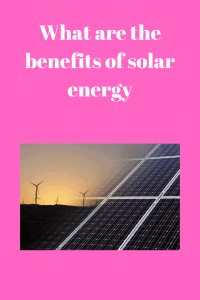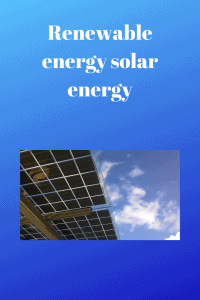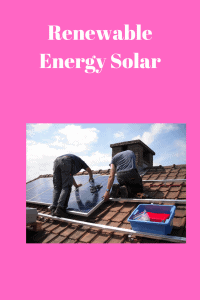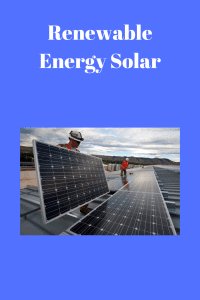
What are the benefits of solar energy? will give you overview of the benefits of solar energy.
Solar power is one of the fastest-growing platforms for producing cleaner and larger environmental energy.
The entire world has noted the damage caused by increased carbon emissions from burning fossil fuels.
So there is an urgent need to switch to alternative methods and try to reduce carbon emissions.
Solar energy is probably the only solution we can all rely on.what are the benefits of solar energy? The benefits of solar energy are as follows:
Renewable energy
Unlike fossil fuels such as oil, coal, and gas, solar power is sustainable.
The Sun does not disappear, and because the use of its power does not dissipate its power, it is an endless source of energy.
This reduces the US dependence on the current system as well as foreign energy sources.
Solar Energy can Save Money.
Reducing our dependence on foreign energy frees us financially from paying higher prices. If we depend on fossil fuels, energy prices will continue to rise.
Costs affect many areas of our lives, from pumps and electricity to our tables.
If there are more people to produce energy, then our demand for oil imports will decrease, as will demand the power grid and associated costs.
After installing the system, there is no further drilling, refining, etc. related to the continuous flow of energy.
The government encourages the use of alternative energy sources.
Tax deductions and deductions can be used to reduce the cost of installing a new system at home.
The quantity can vary by location, and you should check the things available at the federal and state level in your area, but any help to reduce costs is beneficial and can be extremely beneficial in the long run.
Solar home systems are reliable and require little maintenance.
After the system is installed, the only real maintenance to ensure the optimal operation is periodic cleaning or vacuuming of solar cells.
Dust collection is bad for sunlight collection but requires minimal maintenance.
PV cells are covered with an average warranty of about 25 years, making a substantial investment and showing their reliability over long distances.
To prove longevity and minimal maintenance, it is sufficient to consider that satellites have been operated by photovoltaics in more difficult home conditions for years and operate properly for years.
Environmentally friendly
What are the benefits of solar energy?

Along with its power generation and heating capacity, solar power is inherently cost-effective and unpublished and is often considered the best of these energy sources.
In particular, the ecological nature of this source is expected to emerge in the future.
The sun provides heat and light during the day. Also, electricity can be provided at night, provided that the solar power system is connected to the grid or which has a rear battery.
More jobs for talented people

People will also get a good source of work with solar energy.
There are many different functions in this area, such as solar panel production, installation, monitoring, and maintenance.
If you think this is easy, you can try a design, development, cultural integration, and other political tasks.
Renewable energy solar energy

Solar energy is one of the perfect renewable energy, especially for the country where the sun shines frequently.
renewable energy solar energy is not a new technology, but because of recent technological advances, it has become an excellent alternative to fossil-fuel electricity.
Wouldn’t it be wise to use free solar energy instead of depleting our already dwindling fossil fuel reserves?
The greenhouse effect does not increase as a reward for the use of solar energy.
The renewable solar system will not add a share of environmental pollution over a 30-year lifespan.
During the year, the sun shines between 900 and 1,200-kilowatt-hours per square meter
– hard to believe in a wet and winding winter day
– and is used to generate electricity using solar panels (solar) or hot water.
The solar panel can be used.
PV Panel
Photovoltaic panels produce solar energy. Without much technical knowledge, photons transfer their energy to electrons in a silicon crystal and produce a direct current of 12 volts.
It is then passed through the inverter to make it suitable for 240 V circuits.
Panels are ideal for buildings that consume a lot of electricity in a day, such as an office, but should never be seen in isolation because the energy they produce requires excessive storage of batteries.
The average photovoltaic panel production capacity is 1.5 to 2kWp.
This is enough to save about one-fifth of your annual electricity needs at home.
However, energy production changes seasonally and has an impact on the cost of electrical installations.
At the height of summer, the maximum capacity may be able to meet all the needs of the building.
Three types of systems are available:

Monocrystalline panels represent the most efficient group of about 15% of the total energy
– The remainder is lost in the conversion process; the crystal panels are less efficient, collecting 13% of potential energy; the proportion of amorphous silicon thin-film panels is only 7%
– It can be used only in buildings with large ceiling space.
Provided that the panel is on the same slope of the ceiling and does not boast the appearance of the roof, a building permit must be issued.
However, it is worth examining the past of the local authorities in these cases.
After installation, there are no operation and maintenance costs, except occasionally cleaning, and the panel should last for 30 years.
So far, the absorption of photovoltaic panels has been low.
This is mainly because the repayment period can be very long – from 60 to 120 years – because the UK energy industry pays such a low rate for every power sold on the grid.
In other European countries, some countries require a three-fold recovery of the electricity paid, which greatly reduces the repayment time and increases the use of panels.
Solar thermal panel

The solar water heating system collects the radiant energy of the sun and turns it into usable heat as hot water.
Since the demand for hot water is low in offices, according to the Energy Saving Trust, its main use is in residential buildings, where it can provide almost all hot water in the summer months.
It can reduce carbon dioxide emissions from 0.4 to 0.75 tons per year, depending on fuel conversion.
– There are two systems available. Flat panels are a cheaper and less efficient alternative.
These rectangular glass panels usually work best on hot days and use a metal suction plate that comes into contact with the water pipe.
– Empty pipes are more efficient and, therefore, more expensive.
Their energy comes from the light that enters the thermal glass tube and is heated in water by being absorbed, such as black paint.
Both systems pump hot water (mixed with freezing) through heat exchangers connected to hot water tanks.
– Panels range from 0.7 square meters to 8 meters – Empty pipes usually take up less space. Most manufacturers typically suggest that the commission will provide two-thirds of the annual demand for hot water to the home.
– Flat-panel age should be between 10 and 25 years, and pipes should be empty for 20 to 35 years. Withdrawal is usually about ten years.
Renewable Energy Solar

Solar energy is a clean alternative renewable energy, unlike fossil fuels that pollute the environment, threaten our health, and contribute to global warming.
As an extremely rich energy source, solar is the energy of the future.
In the broad sense, solar energy enables life on planet Earth and is the basis for almost every energy we use.
The sun encourages plants to grow, which we can later burn as biomass, if the plant mass wears off to rot in the swamps and underground for millions of years, producing coal and oil.
Sun heat causes temperature differences between areas, producing wind that drives windmills.
The water evaporates due to the sun, falls in the form of rain, returns to the rivers and the sea and during its movement triggers hydro turbines.
However, the term solar energy usually refers to the direct use of solar energy to generate heat or electricity.
All coal, oil and natural gas reserves together are equal to solar energy that reaches Earth in 20 sunny days.
One-third of this light is reflected into space, and some of it is also absorbed in the atmosphere. Deserts, with very dry air and low cloud cover, receive the most solar energy.
The sun’s energy varies during the seasons, with some areas receiving very little sunlight during the winter.
For the production of electricity and thermal energy, solar panels and solar collectors use only a certain part of this energy, depending on their efficiency.
Passive solar energy

One simple, obvious way to harness the sun’s energy is by lighting and heating our apartments and business premises.
If designed properly, facilities can accept the heat of the winter in winter and reduce their acceptance in the summer while using sunlight to illuminate throughout the year.
Objects designed in this way utilize passive solar energy — a natural resource for renewable energy.
Simple adjustments when designing an object, such as correctly orienting the object to the south, installing most windows on the south side of the building, installing skylights, awnings, and trees that will make shadows are techniques for harnessing passive solar energy.
Facilities designed with particular reference to the use of solar energy can be comfortable and beautiful places to live and work.
Thermal solar collectors
Thermal solar collectors are devices that collect solar energy and convert it into thermal energy.
There are three types of collectors: most commonly used solar collectors, selective solar collectors, less commonly used, they receive only rays of a given wavelength and can reach higher temperatures than planes, and there are concentrating solar collectors, their principle is to the surface of the sun’s rays collect and direct to small areas of the receiver.
Solar collectors are installed on the roofs of buildings to collect solar energy for space heating, water heating, and room cooling.
The heat obtained from solar collectors can also trigger the cooling system.
In desiccant evaporators, heat from solar collectors is used to extract humidity from the air.
When the air gets drier, it also gets colder. The warm moist air is separated from the cold air and ejected outward.
Conventional refrigerators and air conditioners operate on this principle. Solar collectors can also be used to heat the pool.
Solar power generation systems

These systems can be solar power plants, that is, a technological system that uses solar energy and converts it into electricity in several stages.
Solar panels are devices made up of solar cells — smaller devices that convert solar energy into electrical energy through the photoelectric effect.
The energy produced by a solar panel is called solar energy, and photovoltaic cells collect light from other sources, so the light source is not just the sun, they can also be used as an electromagnetic radiation collector.
Most solar panels are used for standalone photovoltaic systems, providing electricity to remote households, transmitters of mobile operators, roadside signs, water pumps, and millions of solar clocks and digits.
Developed countries see solar panels as a way to avoid building long and skimpy transmission lines to remote locations.
More recently, thanks to the lower prices of solar panels, strong initiatives, and advanced systems for measuring electricity consumption.
Energy solar panels have begun to be increasingly installed in grid-connected solar systems and are thus becoming more prevalent in households, offices and other facilities already connected to the electricity distribution network.
Photovoltaic systems have a wide application, from use to very small systems such as clocks, digits, through smaller tourist boats and individual households isolated from electricity sources to large systems connected to the electricity grid.
Solar water heating systems can compete economically with conventional systems and the eventual tax breaks that some states give them to make it even more affordable.
Renewable energy solar could play a bigger role in overall electricity production and greater energy independence.
Also, solar energy reduces dependence on fossil fuels, reduces air pollution and thus combats global warming
Conclusion
As people become more aware of solar energy and its activities, its benefits will become better known, and it can only be a matter of time before solar energy will be present in almost all aspects of our daily lives.
The problems of pollution and global warming of fossil fuels are a constant problem that can be solved by choosing this type of energy source.
Best Solar Energy on Amazon